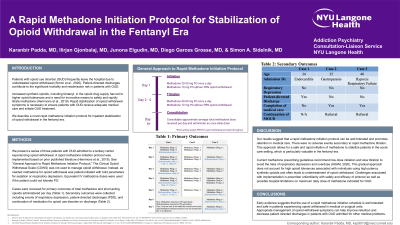Substance Use and Related Disorders
Session: Poster Session
(177) A Rapid Methadone Initiation Protocol for Stabilization of Opioid Withdrawal in the Fentanyl Era

Trainee Involvement: Yes

Karanbir Padda, MD
Assistant Professor of Clinical Psychiatry
New York-Presbyterian/Weill Cornell Medical Center
Brooklyn, New York, United States- IG
Ilirjan Gjonbalaj, MD
Consultation-Liaison Psychiatry Fellow
NYU
New York, New York, United States 
Junona Elgudin, MD
Assistant Professor of Psychiatry
Mount Sinai Beth Israel
Astoria, New York, United States
Diego Garces Grosse, MD
Clinical Assistant Professor
NYU Langone Health
NY, New York, United States
Simon A. Sidelnik, M.D.
Director Addiction Consultation-Liaison Psychiatry
NYU Grossman School of Medicine
New York, New York, United States
Presenting Author(s)
Co-Author(s)
Simon R, Snow R, Wakeman S. Understanding why patients with substance use disorders leave the hospital against medical advice: A qualitative study. Subst Abus. 2020;41(4):519-525. doi: 10.1080/08897077.2019.1671942. Epub 2019 Oct 22. PMID: 31638862. Hemmons P, Bach P, Colizza K, Nolan S. Initiation and Rapid Titration of Methadone in an Acute Care Setting for the Treatment of Opioid Use Disorder: A Case Report. J Addict Med. 2019 Sep/Oct;13(5):408-411. doi: 10.1097/ADM.0000000000000507. PMID: 30741835; PMCID: PMC6682456. The ASAM National Practice Guideline for the Treatment of Opioid Use Disorder: 2020 Focused Update. J Addict Med. 2020 Mar/Apr;14(2S Suppl 1):1-91. doi: 10.1097/ADM.0000000000000633. Erratum in: J Addict Med. 2020 May/Jun;14(3):267. PMID: 32511106.
Background: Patients with opioid use disorder (OUD) frequently leave the hospital due to undertreated opioid withdrawal (Simon et al., 2020). Patient-directed discharges contribute to the significant mortality and readmission risk in patients with OUD. Increased synthetic opioids, including fentanyl, in the opioid drug supply has led to higher opioid tolerances and a need for innovative means to safely and rapidly titrate methadone (Hemmons et al., 2019). Rapid stabilization of opioid withdrawal symptoms is necessary to ensure patients with OUD receive adequate medical care and initiate OUD treatment. We describe a novel rapid methadone initiation protocol for inpatient stabilization of opioid withdrawal in the fentanyl era.
Methods: We present a series of several cases of patients with OUD admitted to a tertiary center and experiencing opioid withdrawal. Patients were initiated on methadone 20-30mg with an additional 10mg every 4 hours as needed (PRN), up to a maximum total 70-80mg daily. Short-acting opioids were prescribed as needed for breakthrough withdrawal symptoms. Patients were continued on methadone 40-50mg daily with additional PRN administrations. Once steady state was reached, methadone dosages were consolidated.
Results: The series of cases demonstrates a novel rapid methadone initiation strategy in which patients can receive up to 70-80mg starting on the day of presentation. The patients highlighted in the series remained in the hospital to complete their acute medical care and did not develop adverse effects. No patients suffered from respiratory depression or needed opioid reversal.
Discussion: Current methadone prescribing guidelines recommend low dose initiation and slow titration to avoid the risks of respiratory depression and overdose (ASAM, 2020). This approach does not account for higher opioid tolerances due to the growing use of fentanyl in the opioid drug supply, and often leads to inadequate treatment of opioid withdrawal. We describe a group of patients with OUD admitted to a tertiary center for treatment of acute medical issues and seen by our addiction consult service for management of opioid withdrawal. Our results indicate that a rapid methadone initiation protocol is well tolerated and promotes retention in medical care. There were no adverse events secondary to rapid methadone titration. This approach allows for a safe and rapid initiation of methadone to stabilize patients, which is particularly valuable in the fentanyl era.
Conclusion: Rapid methadone titration can be used safely to treat opioid withdrawal and ensure patients with OUD receive necessary acute medical care.
References:

